 W
WAdler is a Belgian comic series written and drawn by the Belgian author René Sterne (1952–2006) and colored by his wife Chantal De Spiegeleer.
 W
WAlix, or The Adventures of Alix, is a Franco-Belgian comics series drawn in the ligne claire style by Jacques Martin. The stories revolve around a young Gallo-Roman man named Alix in the late Roman Republic. Although the series is renowned for its historical accuracy and stunning set detail, the hero has been known to wander into anachronistic situations up to two centuries out of his era. The stories unfold throughout the reaches of the Roman world, including the city of Rome, Gaul, the German frontier, Mesopotamia, Africa and Asia Minor. One voyage goes as far as China.
 W
WAlpha is a Franco-Belgian comics series written by Pascal Renard, illustrated by Youri Jigounov and published by Le Lombard in French and Cinebook in English.
 W
WBarelli is a comics series featuring an eponymous character, created by Bob de Moor, which first appeared in the Franco-Belgian comics magazine Tintin on July 27, 1950. Barelli made sporadic serial runs throughout the 1950s, 1960s and 1970s while 8 albums in the series were released by Lombard and Bédescope.
 W
WBenoît Brisefer is a Belgian comic strip created in 1960 by Peyo and published by Le Lombard, about a little boy whose peaceful, innocent appearance, charm and good manners covers his possession of superhuman strength. Since Peyo's death it has been continued by other artists and writers. Parts of the series have been published in a number of languages around the world.
 W
WBlake and Mortimer is a Belgian comics series created by the Belgian writer and comics artist Edgar P. Jacobs. It was one of the first series to appear in the Franco-Belgian comics magazine Tintin in 1946, and was subsequently published in book form by Les Éditions du Lombard.
 W
WBruno Brazil is a Franco-Belgian comics series written by Greg, under the pseudonym Louis Albert, and drawn by William Vance. It was initially serialised in the Franco-Belgian comics magazine Tintin, first appearing on January 17, 1967. The first album publication was in 1969, while the latest album was first published in 1995.
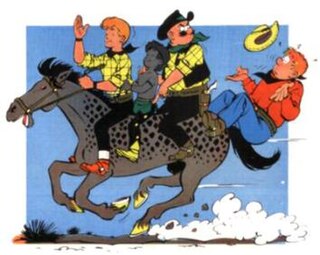 W
WChick Bill is a Franco-Belgian humorous Western comic book series created by Tibet. It was first published in 1953 in the Franco-Belgian comics magazines Ons Volkske and Chez Nous Junior, and began serial publication on October 19, 1955 in Tintin magazine under the title Les aventures de Chick Bill le cow-boy. 70 books of the series were published, and it lasted until Tibet's death in 2010. Tibet wrote many of the scripts as well as drawing all the episodes, but various stories were written by André-Paul Duchâteau and Greg and one episode was scripted by René Goscinny. Frank Brichau was credited as co-illustrator for the last two books.
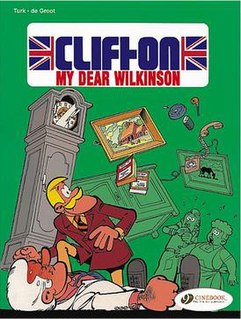 W
WClifton is a Franco-Belgian comics series in the humorous spy-genre, featuring the exploits of Colonel Sir Harold Wilberforce Clifton. It was created by Raymond Macherot in 1959, and has since passed on to other artists and writers. Over the fifty years of publication of the Clifton series, approximately twenty albums and twenty smaller stories have been published, totalling about 800 pages.
 W
WHermann Huppen is a Belgian comic book artist. He is better known under his pen-name Hermann. He is most famous for his post-apocalyptic comic Jeremiah which was made into a television series.
 W
WCori, de Scheepsjongen was a Belgian comics series (1952–93) by Bob de Moor. It is a historical adventure strip set in the 16th century, drawn in a realistic style with much attention to detail. It is often regarded as De Moor's magnum opus.
 W
WCrusade is a Franco-Belgian comics series written by Jean Dufaux, illustrated by Philippe Xavier and published by Le Lombard in French and Cinebook in English.
 W
WCubitus is a Franco-Belgian comics series, and the basis for the Wowser cartoon series appearing in the United States. Cubitus was created by the Belgian cartoonist Dupa, and features Cubitus, a large anthropomorphic dog, who lives with his owner Semaphore. Cubitus is known as Dommel in Flanders and the Netherlands, Muppelo or Pom Pom in Finland, Teodoro in Italy and Доммель in Russia. His name derives from the old anatomical name of the ulna bone, supposedly derived from the Greek kybiton (elbow).
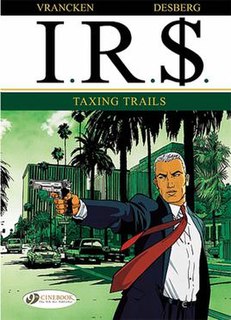 W
WIR$ is a Franco-Belgian comics series written by Stephen Desberg, illustrated by Bernard Vrancken and published by Le Lombard in French and Cinebook in English.
 W
WJohan and Peewit is a Belgian comics series created by Peyo. Since its initial appearance in 1947 it has been published in 13 albums that appeared before the death of Peyo in 1992. Thereafter, a team of comic book creators from Studio Peyo continued to publish the stories.
 W
WLéonard in French, and Leonardo in the Dutch translation, is a Belgian comic series about an eponymous inventor and his assistant. It was created by artist Philippe Liégeois and writer Bob de Groot, better known under their pennames "Turk & De Groot".
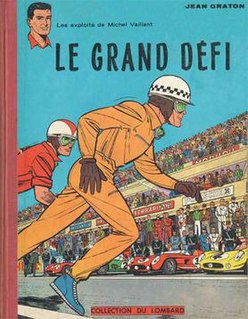 W
WMichel Vaillant is a French comics series created in 1957 by French cartoonist Jean Graton and published originally by Le Lombard. Later, Graton published the albums by himself when he founded Graton éditeur in 1982. Michel Vaillant is the main character of the eponymous series, a French racing car driver who competes mainly in Formula One.
 W
WModeste and Pompon is a Belgian comic series consisting mainly of humorous one-page short stories about a temperamental young man and his girlfriend. Created by André Franquin, it was first published in Tintin magazine on October 19, 1955.
 W
WOumpah-pah le Peau-Rouge is a comics series created by comics artist Albert Uderzo and comics author René Goscinny, best known as the creators of Asterix. The series first appeared in the weekly Tintin magazine in 1958 though it remained serialised for a relatively short time, ending in 1962. The stories were published in book form by Lombard and Dargaud starting in 1961. In 1995, the series was reissued by Albert Uderzo's own publishing house, Les Éditions Albert-René.
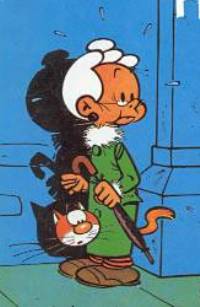 W
WPrudence Petitpas was a Belgian comics series, created by Maurice Maréchal.
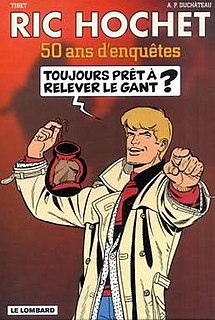 W
WRic Hochet is a Franco-Belgian comics series created by Tibet (drawings) and André-Paul Duchâteau (scripts). It first appeared on March 30, 1955 in the Franco-Belgian comics magazine Tintin.
Rork is a series of eight graphic novels by German comic author Andreas. It is also the name of the protagonist of the series.
 W
WSimon du Fleuve is a post-apocalyptic French graphic novel series written by Claude Auclair, with five volumes published between 1976–1978, and a second cycle of four albums from 1988-1989. Simon du Fleuve started in the pages of Tintin magazine. The heirs of Jean Giono have stated that elements of the story are stolen in Auclair's prequel of Simon du Fleuve named La balade de Cheveu-Rouge from Giono's Le chant du monde.
 W
WThe Smurfs is a Belgian comic series, created by cartoonist Peyo. The titular creatures were introduced as supporting characters in an already established series, Johan and Peewit in 1958, and starred in their own series from 1959. Thirty Smurf comic albums have been created, 16 of them by Peyo. Originally, the Smurf stories appeared in Spirou magazine with reprints in many different magazines, but after Peyo left the publisher Dupuis, many comics were first published in dedicated Smurf magazines, which existed in French, Dutch and German. A number of short stories and one page gags have been collected in comic books next to the regular series of 30. By 2008, Smurf comics have been translated into 25 languages, and some 25 million albums have been sold.
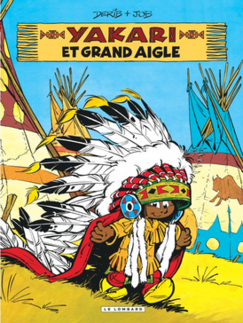 W
WYakari is a Franco-Belgian comic book series, aimed at a younger audience, originally written by Job, and illustrated by Derib, both from Switzerland. The series is now written by Frenchman Joris Chamblain.
 W
WYoko Tsuno is a comics album series created by the Belgian writer Roger Leloup published by Dupuis in Spirou magazine since its debut in 1970. Through twenty-nine volumes, the series tell the adventures of Yoko Tsuno, a female electrical engineer of Japanese origin surrounded by her close friends, Vic Video and Pol Pitron. Their adventures bring them to, among other places, Belgium (Bruges), Germany, Scotland, Japan, Hong Kong, Indonesia and also into outer space. The stories are heavily technology driven, with concepts like robot dragons, suspended animation, time travel, and even an alien species called the Vineans. Despite the often exotic settings and science-fiction plot lines, the stories generally remain realistic on the personal level between the characters and friendship, love and spirituality are some of the key themes of the series. The art is drawn in Ligne claire style, although having originally started out in the Marcinelle style. When depicting real-world settings, Leloup aspires to be as true to reality as possible, with places like Burg Katz or Rothenburg ob der Tauber depicted with almost photographic skill.